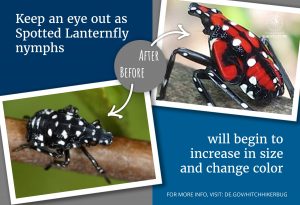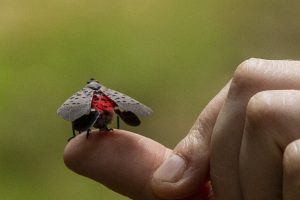DOVER, Del. (July 12, 2022) — Five years after the first confirmed spotted lanternfly was found in New Castle County in 2017, the spotted lanternfly has made its way to Sussex County, creating a statewide quarantine for this invasive pest.
The spotted lanternfly is a destructive invasive planthopper that attacks many hosts, including trees, shrubs, orchards, grapes, and hops. The insect is detrimental to Delaware’s agricultural industry, forests, and residential areas.
Effective July 12, the Delaware Department of Agriculture (DDA) will expand the quarantine to include Sussex County due to established populations of spotted lanternfly found in Georgetown, Milford, Seaford, Ocean View, and Rehoboth. Quarantine means that residents, businesses, or municipalities cannot move any material or object that could harbor the pest without taking precautions to prevent the spread. Adults can fly, hop, or drop onto a vehicle – meaning that this pest can be easily transported to new areas where it can create another infestation.
“It is practically impossible to eradicate the spotted lanternfly because of its status as a hitchhiker bug,” said Deputy Secretary of Agriculture Nikko Brady. “For a small state, our Spotted Lanternfly Program has done an excellent job in fending off the spread of this invasive insect for five years and are just now finding it in Sussex County.”
Since the initial population of spotted lanternfly was found in 2018, DDA has partnered with USDA to conduct surveys and assessments. Overall, the Spotted Lanternfly Program has treated 23,721 acres with insecticides or herbicides to reduce Delaware’s spotted lanternfly population. Once the females began laying egg masses this past fall, the team scraped 90,147 egg masses with 30-50 eggs in each, significantly reducing this year’s population.
Due to quarantines in other states, interstate commerce will be impacted if the pest is transported out of the Delaware quarantine area. Therefore, DDA’s Spotted Lanternfly Program is focused on priority properties that are pathways for the movement of spotted lanternfly, including highways, railways, public transportation, and distribution centers. The Program’s inspectors use the tree of heaven, an invasive necessary for spotted lanternfly to reproduce, to search for the insect.
Managing Spotted Lanternfly
 Homeowners are encouraged to visit Delaware’s spotted lanternfly website at https://de.gov/hitchhikerbug to learn what the quarantine means and how to manage this invasive pest. The Delaware Homeowner Spotted Lanternfly and Treatment Fact Sheet lists pesticides labeled for planthoppers or leafhoppers sold at local home and garden stores, which can be used to kill the insect. Residents can do their part by treating nymphs and adults from May to November and scraping and destroying egg masses from December to May. Homeowners can also hire a commercially licensed turf and ornamental pesticide applicator to treat their properties for these insects.
Homeowners are encouraged to visit Delaware’s spotted lanternfly website at https://de.gov/hitchhikerbug to learn what the quarantine means and how to manage this invasive pest. The Delaware Homeowner Spotted Lanternfly and Treatment Fact Sheet lists pesticides labeled for planthoppers or leafhoppers sold at local home and garden stores, which can be used to kill the insect. Residents can do their part by treating nymphs and adults from May to November and scraping and destroying egg masses from December to May. Homeowners can also hire a commercially licensed turf and ornamental pesticide applicator to treat their properties for these insects.
In Delaware, spotted lanternfly nymphs are in the third and fourth instar stages and will metamorphize into adults before the end of July. From now until early September, trees are actively moving phloem from the trunk into the branches, which feed the tree’s growth. At this time, using a systemic insecticide is preferred because it is absorbed by tree roots, bark, or leaves and is moved through its vascular system to other parts of the tree. This means that no matter what area the spotted lanternfly feeds on, it will ingest the insecticide and die.
Eliminating the tree of heaven helps decrease the spotted lanternfly population. The tree of heaven is found in industrial parks, unmanaged areas, or vacant lots, and along highways and railways. Municipalities and businesses should prioritize destroying the female tree of heaven while leaving some male specimens as trap trees. The average homeowner does not have tree of heaven on their properties, but the homeowner should remove it if identified.
Delaware Spotted Lanternfly Quarantine and Permitting
The general public is encouraged to download and print the Delaware Resident Spotted Lanternfly Compliance Checklist, indicating that you inspected and know that no living life stage of the spotted lanternfly is present on regulated articles before moving them. The checklist is available online at https://de.gov/hitchhikerbug. DDA recommends keeping the checklist in each vehicle’s glove box and noting the date when specific items on the list are inspected before transport.
Examples of regulated articles include:
• Any living life stage of the spotted lanternfly
• Landscaping, remodeling, or construction materials
• Firewood of any species
• Packing materials (e.g., wood crates, boxes)
• All plants and plant parts, including all live and dead trees, perennial and annual plants, and mulch
• Outdoor household articles like RVs, lawnmowers, chairs, grills, tarps, tile, stone, deck boards, and other vehicles not stored indoors.
Any person conducting business for a commercial company, a municipality, or a government agency that requires movement of any regulated item within or from the quarantine area must have a permit, available through the DDA spotted lanternfly website. To obtain a permit, a designated individual from an organization must receive training and pass an online test to demonstrate a working knowledge and understanding of the pest and quarantine requirements. This individual is then required to train other employees to inspect vehicles and products and remove any spotted lanternfly life stages. The permit demonstrates that the individual understands how to identify the pest and ensure the items transported are not carrying the insect.
Reporting Spotted Lanternfly
 Residents who live near the Dover Air Force Base or in Sussex County are encouraged to report sightings of the spotted lanternfly. Citizen reports help DDA inspectors determine how these insects move and which transportation pathways they utilize. These reports also allow DDA to notify agricultural operations with plants vulnerable to this insect. Residents can make a report by using the online form at https://de.gov/hitchhikerbug or emailing HitchHikerBug@delaware.gov and including the location of the find in the subject line. Due to the high level of reporting, DDA inspectors will not respond to emails but will use the information provided to determine if a new spotted lanternfly population is present.
Residents who live near the Dover Air Force Base or in Sussex County are encouraged to report sightings of the spotted lanternfly. Citizen reports help DDA inspectors determine how these insects move and which transportation pathways they utilize. These reports also allow DDA to notify agricultural operations with plants vulnerable to this insect. Residents can make a report by using the online form at https://de.gov/hitchhikerbug or emailing HitchHikerBug@delaware.gov and including the location of the find in the subject line. Due to the high level of reporting, DDA inspectors will not respond to emails but will use the information provided to determine if a new spotted lanternfly population is present.
Additional Information
In March 2019, DDA initially quarantined zip codes in New Castle County, where an established population of reproducing spotted lanternfly was found. The quarantine was expanded in September 2019 to include all areas of New Castle County north of the Chesapeake and Delaware Canal and finally included the entire county in July 2020. DDA quarantined Kent County in October 2020, when established populations of the insect were found in Smyrna, Dover, and Harrington.
###
 Homeowners are encouraged to visit Delaware’s spotted lanternfly website at https://de.gov/hitchhikerbug to learn what the quarantine means and how to manage this invasive pest. The Delaware Homeowner Spotted Lanternfly and Treatment Fact Sheet lists pesticides labeled for planthoppers or leafhoppers sold at local home and garden stores, which can be used to kill the insect. Residents can do their part by treating nymphs and adults from May to November and scraping and destroying egg masses from December to May. Homeowners can also hire a commercially licensed turf and ornamental pesticide applicator to treat their properties for these insects.
Homeowners are encouraged to visit Delaware’s spotted lanternfly website at https://de.gov/hitchhikerbug to learn what the quarantine means and how to manage this invasive pest. The Delaware Homeowner Spotted Lanternfly and Treatment Fact Sheet lists pesticides labeled for planthoppers or leafhoppers sold at local home and garden stores, which can be used to kill the insect. Residents can do their part by treating nymphs and adults from May to November and scraping and destroying egg masses from December to May. Homeowners can also hire a commercially licensed turf and ornamental pesticide applicator to treat their properties for these insects. Residents who live near the Dover Air Force Base or in Sussex County are encouraged to report sightings of the spotted lanternfly. Citizen reports help DDA inspectors determine how these insects move and which transportation pathways they utilize. These reports also allow DDA to notify agricultural operations with plants vulnerable to this insect. Residents can make a report by using the online form at https://de.gov/hitchhikerbug or emailing
Residents who live near the Dover Air Force Base or in Sussex County are encouraged to report sightings of the spotted lanternfly. Citizen reports help DDA inspectors determine how these insects move and which transportation pathways they utilize. These reports also allow DDA to notify agricultural operations with plants vulnerable to this insect. Residents can make a report by using the online form at https://de.gov/hitchhikerbug or emailing